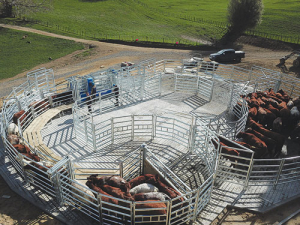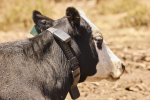And the Oamaru firm has since gone into animal husbandry tools, e.g. docking irons, de-horners and more lately the Revolution self-powered dosing gun.
But its well-designed and manufactured cattle handling equipment and yards have become more topical with the changes in 2014 to health and safety regulations, and the sobering fact that 15,000 people are injured in NZ each year in animal-related accidents.
Te Pari chooses to manufacture from steel rather than timber for its yarding.
It uses NZ-made oval steel tube (Cattlerail) for its horizontal rails, reckoned as strong as square-section material but with a large, flat side to the profile making it animal-friendly and anti-bruise.
Handling is easy by one person. The curved, narrow pens encourage animals to move to the front of the yards, while circular forcing gates allow users to reduce the pen size and keep animals moving.
The company offers a range of standard layouts and purpose-built designs to suit individual situations, calling on experienced staff in-field and at base.
An example is Ian King, with 20 years of experience working with tools and steel; he understands the possibilities of steel so can incorporate technical requirements into his designs.
Using CAD software, King turns the company’s sales team’s requests into working layouts.
“I try to think like a cow; their greatest emotion is fear so I work to influence the way cattle will respond to handling,” he explains.
“This includes taking in points such as unfamiliar surroundings and areas of shadow.”
King says many other products in the market hark back to designs and materials of 50 years ago – often long straight races and square pens.
Te Pari prefers steel over timber because the latter needs to be concreted in place, leading to ponding at the base of posts and consequent rotting. The company believes timber designs cannot be easily adapted and the construction methods mean they can’t be moved.
Also, timber warps, cracks, weakens and ultimately breaks, so such yards need more maintenance.
Te Pari says the ultimate consideration for a steel yard design goes back to understanding a key aspect of animal psychology: broad, wooden rails obstruct an animal’s vision, causing it to hesitate to move forwards instinctively because it cannot see an exit.

















